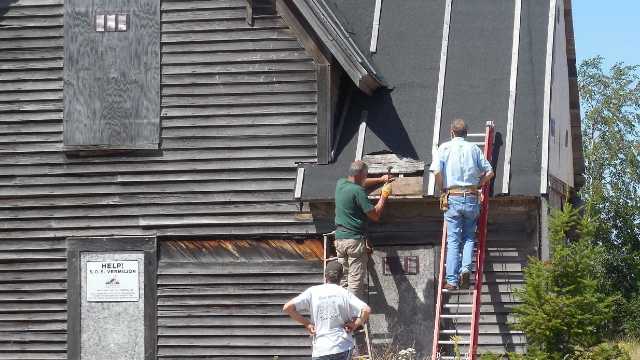By Sterling McGinn
On a lonely shore of Lake Superior, approximately 13.1 miles from Paradise, an old sentinel is getting a new lease on life thanks to a preservation group known as S.O.S. Vermilion.
The site of the old Vermilion Life-Saving Station still contains the original station building, which was constructed in 1876 by the U. S. Life- Saving Service. Years of neglect and harsh Lake Superior storms have taken a toll on the building. But, Thanks to caring individuals the historic structure is in the process on being restored.
The Vermilion Station officially opened on May 27, 1877, and was one of four constructed at the same time, using the same architectural plans. These stations were constructed on what was known as the “Shipwreck Coast.” The other stations built in 1876 included the Muskallonge Lake Station (later known as Deer Park Station), Two Heart River Station and Crisp Point Station.
The first aids to navigation on Lake Superior were built by the U.S. Lighthouse Service at Whitefish Point and Copper Harbor in 1849, but more protection was needed for the many ships hauling iron ore and lumber.
The life-saving stations were manned by seasonal full-time crews whose job was to come to the rescue of distressed sailors close to shore. While not out rescuing sailors, surfmen performed rigorous daily drills and trainings.
“The men of the U.S. Life-Saving Service, a predecessor to the Coast Guard, risked their lives each time they rowed out in storms to rescue victims of shipwrecks,” said Grace Truman, who serves as the president of S.O.S. Vermilion. “Despite their heroism, their stories are mostly forgotten.”
In 1915, the U. S. Life- Saving Service merged with the Revenue Cutter Service to become the U. S. Coast Guard.
In 1938 and 1939, the Coast Guard constructed three new buildings at Vermilion: a boathouse, crew’s quarters, and a house for the officer in charge. These buildings still stand.
By 1944, the U.S. Coast Guard officially closed the Vermilion Station. Three years later, the buildings and land were sold to a private party.
Over the next several decades, the area changed hands several times and in 2007, the Little Traverse Conservancy took ownership of the property.
The Vermillion Point Nature Preserve contains 175 acres of land with wide sandy beaches, low shore dunes, old cranberry bog wetlands, upland forest and a stream. The area is also known for its habitat for the piping plover, which is federally endangered. Researchers from the Nature Conservancy, Lake Superior State University and Michigan Audubon use the property for studies.
S.O.S. Vermilion incorporated as a 501(c) 3 nonprofit organization in 2017 for the purpose of partnering with the Little Traverse Conservancy to restore the original 1876 building.
However, due to a lack of funds, restoration of the building moved slowly but steadily. In June of 2017, volunteers patched the roof, installed vents, covered holes in the walls and cleaned up debris.
“The first phase was removing the dilapidated additions compromising the structural integrity of the original station,” said Truman.
In the fall of 2017, volunteers removed the two additions to the original structure, which were beyond repair.
The following summer, the remaining large addition—which was beyond restoration—was carefully separated from the building.
In 2020, S.O.S. Vermilion acquired the original building from the conservancy and leased the land under and directly around the old building.
The building had severe winter damage to the roof in 2020 and 2021, but those areas were fixed.
One of the biggest projects in moving forward with the restoration was completed this summer. “Digging it out of the sand and getting it on a secure foundation came next,” said Truman.
The organization hired a construction company to build a new foundation and repair the sills, lower walls and floors.
On August 22, the building was moved onto its new foundation.
“When enough money is raised, the building will receive a new roof and exterior restoration,” Truman said.
The organization announced a challenge grant from a generous donor in 2021. They were willing to match every dollar in donations received by S.O.S. Vermilion up to $50,000.
“S.O.S. Vermilion hopes that the bravery and self-sacrifices of the life-savers will be remembered and honored by preserving their building,” Truman said.
For more information on the project and the S.O.S. group, find them on Facebook or visit sosvermilion.org.












